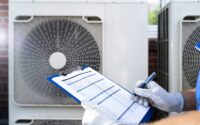In the fast-paced world of commercial construction and maintenance, ensuring the longevity and durability of structures is crucial. A pivotal aspect of this is implementing effective waterproofing solutions. The right waterproofing techniques not only protect buildings from water damage but also enhance the integrity and lifespan of the structure, making them essential for any commercial property. In this guide, we aim to explore various cost-effective commercial waterproofing solutions that are available today.
The Importance of Waterproofing in Commercial Construction
Waterproofing is a critical component of commercial construction for several reasons. The intrusion of water can lead to severe structural damage, which can result in costly repairs and even pose safety risks. Effective waterproofing helps prevent issues such as mold growth, decay, and the deterioration of structural elements. By preventing water ingress, waterproofing preserves the building’s aesthetic appeal and functionality.
Moreover, proper waterproofing can enhance the energy efficiency of a building, as moisture control is directly linked to maintaining insulation performance. This contributes to a more sustainable environment and can significantly lower operational costs. Companies offering commercial construction services often emphasize waterproofing to ensure their projects stand the test of time.
Types of Commercial Waterproofing Solutions
Liquid Membranes
Liquid membranes are versatile waterproofing solutions often used in commercial construction. They are applied as a liquid that cures to form a solid, seamless, and flexible membrane. This method is perfect for irregular shapes and surfaces, ensuring comprehensive coverage without the joint issues associated with sheet systems. Liquid membranes are cost-effective due to their ease of application and durability.
A variety of materials can be used for liquid membranes, including polyurethane, asphalt, and acrylic-based systems. The selection of material depends on the specific requirements of the project, such as exposure to UV light, chemical resistance, and flexibility. Their application can significantly improve the resilience of commercial properties to water infiltration.
Sheet Membranes
Sheet membranes are another common waterproofing solution, typically made from materials like rubber, PVC, or EPDM. These membranes are pre-formed sheets installed on the site through a process of binding to the substrate. While more labor-intensive than liquid membranes, they offer added reliability due to their consistent manufacturing quality.
For those looking for a balance between cost and performance, sheet membranes can be a viable option. They provide extensive protection against water damage, making them a favorite in many commercial projects where large flat surfaces are involved.
Cementitious Waterproofing
Cementitious products are perhaps the simplest waterproofing materials to apply. They are easily mixed and applied with a brush or trowel and are ideal for internal wet areas like restrooms. These solutions are often favored because of their ease of use and the minimal cost involved in their application.
While cementitious waterproofing is highly effective for certain applications, its lack of flexibility compared to other materials limits its use to areas that aren’t subject to significant movement. Despite this, it remains a cost-effective choice for many commercial projects.
Choosing the Best Waterproofing Solution for Your Needs
The selection of a waterproofing solution depends on various factors, including the nature of the project, environmental conditions, and budget constraints. Consultation with experts in waterproofing services can provide valuable insights into the best materials and methods for specific requirements.
For instance, regions with high rainfall or groundwater levels might benefit from heavy-duty sheet membranes, while structures in areas with mild weather might only need liquid membranes or simpler cementitious products. Understanding the specific needs of the building and the surrounding environmental conditions is essential in making an informed decision.
Considerations for Cost-Effective Waterproofing
Long-Term vs. Short-Term Costs
When evaluating waterproofing solutions, it’s essential to consider both initial and long-term costs. A cheaper, less effective solution that requires frequent repairs and replacements can become more expensive over time compared to a more robust, slightly more expensive system that lasts longer without issues.
Investing in quality materials and professional installation reduces the risk of water damage, ultimately saving money by avoiding potential repair costs and prolonging the building’s life. Therefore, balancing quality and price is key when considering cost-effective commercial waterproofing solutions.
Role of Professional Expertise
Hiring professionals with experience in asphalt and concrete services enhances the effectiveness of the waterproofing process. Skilled contractors can provide valuable insights, recommend the best materials, and ensure proper application techniques, which can significantly affect the overall success and cost-effectiveness of the project.
The use of expert services also ensures compliance with local building codes and standards, reducing the likelihood of future legal and safety issues. Ultimately, professional input leads to a more reliable and durable waterproofing solution, which is a prudent financial investment.
Innovations in Waterproofing Technology
As the construction industry evolves, so do waterproofing technologies. Advancements in materials science have led to the development of products that offer better performance, easier application, and reduced environmental impact. For instance, new coatings with nanotechnology provide enhanced protection while being eco-friendly.
Additionally, self-healing membranes that can repair themselves when damaged are becoming more popular. These technologies promise not only to extend the longevity of waterproofing solutions but also offer significant savings by reducing maintenance costs.
Conclusion: Investing in Sustainability and Longevity
As we conclude our exploration into cost-effective commercial waterproofing solutions, it’s clear that choosing the right materials and methods plays a pivotal role in safeguarding buildings from water damage. Whether it’s through liquid membranes, sheet systems, or cementitious products, the key is to ensure that the solution is tailored to the building’s unique requirements and environmental challenges.
By investing in quality products and professional services, and staying informed about technological advancements, businesses can not only save on costs but also contribute to the sustainability and longevity of their structures. Waterproofing is not only a protective measure; it is an investment in the future of your commercial property.
For more detailed information and consulting services, visiting specialists like those who offer commercial construction services can provide further assistance. This strategic approach ensures the best outcomes for your waterproofing needs.








